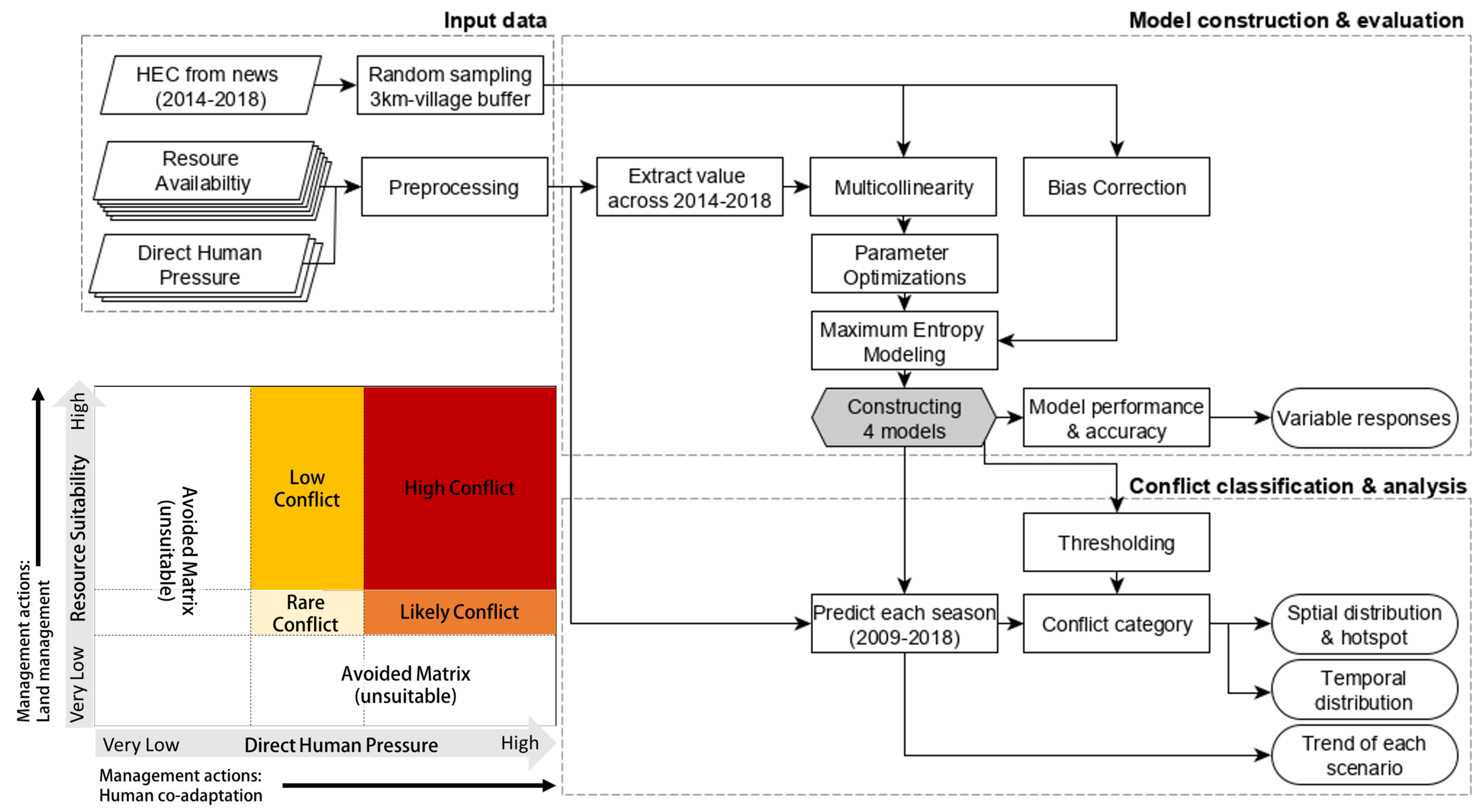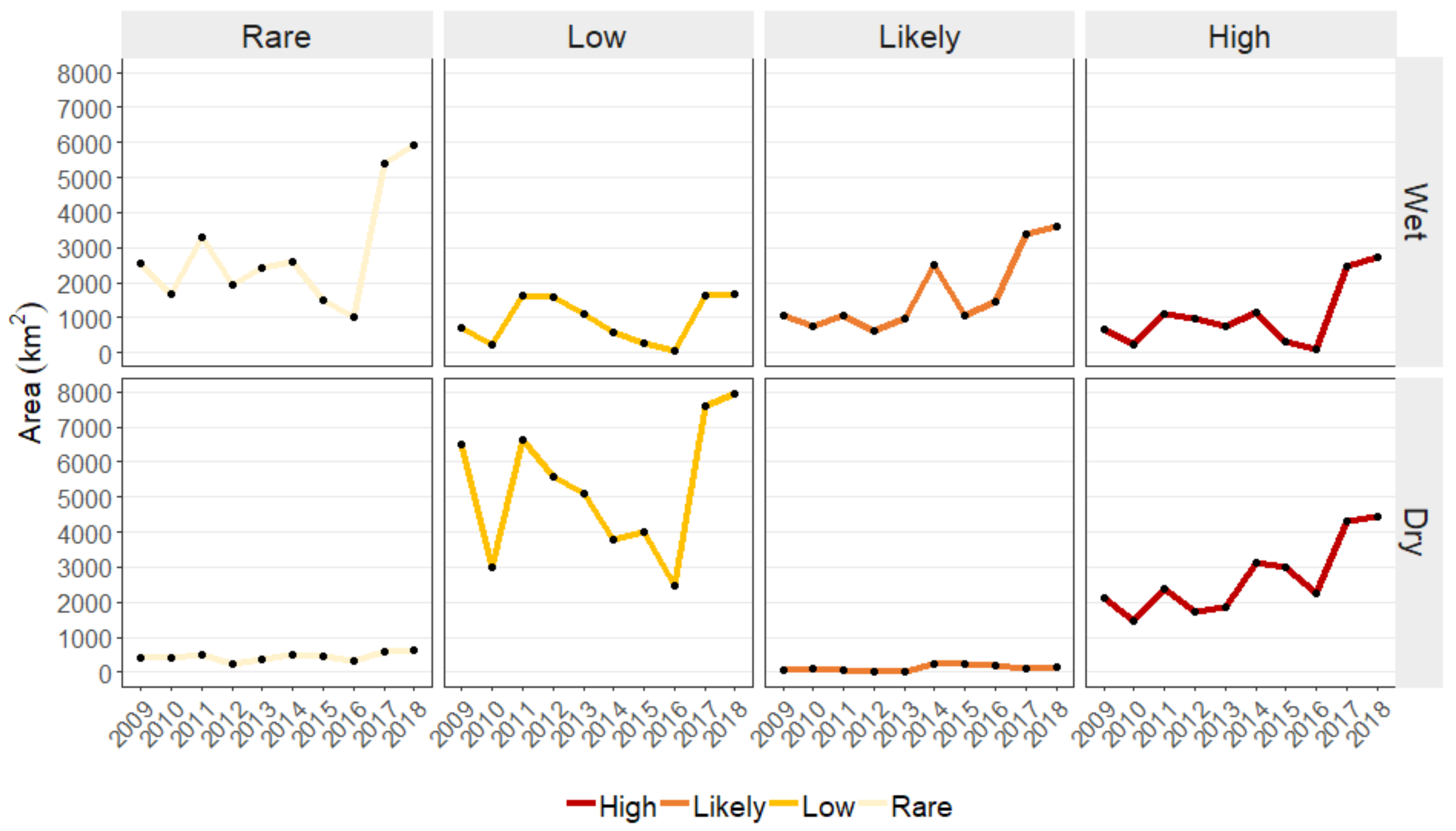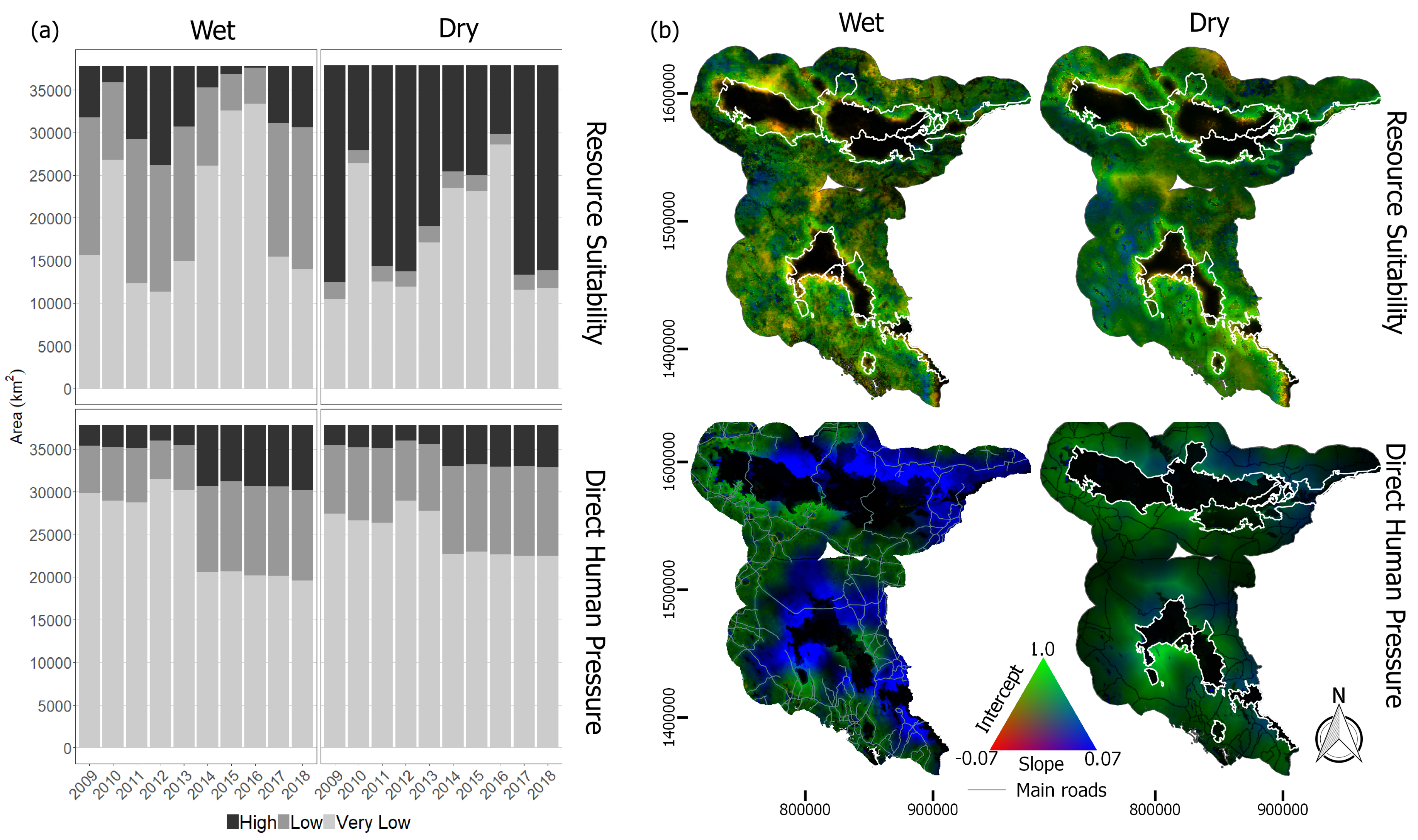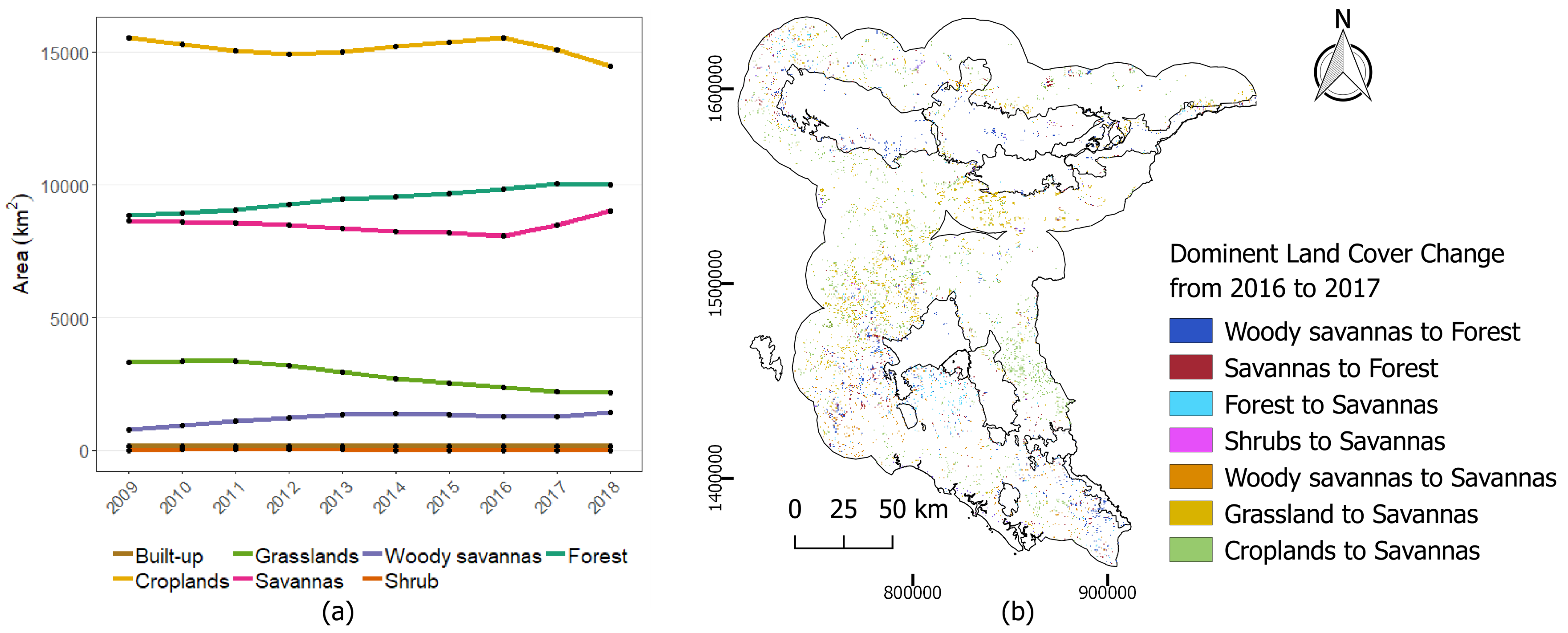Spatiotemporal Distribution of Human–Elephant Conflict in Eastern Thailand: A Model-Based Assessment Using News Reports and Remotely Sensed Data
Abstract
:1. Introduction
2. Materials and Methods
2.1. Study Area
2.2. Data
2.2.1. HEC Occurrence Data
2.2.2. Predictor Variables
2.3. Model Construction and Evaluation
2.3.1. Bias Correction
2.3.2. Maximum Entropy Modeling
2.4. Conflict Classification and Analysis
3. Results
3.1. Model Performance and Variable Responses
3.2. Distribution of Conflict and Conflict Hotspot
3.3. Drivers of Changes in HEC Probability Over Time
4. Discussion
5. Conclusions
Supplementary Materials
Author Contributions
Funding
Acknowledgments
Conflicts of Interest
References
- IUCN/SSC Asian Elephant Specialist Group. Asian Elephant Range States Meeting: Final Report; Technical report; The IUCN Species Survival Commission (SSC): Jakarta, Indonesia, 2017. [Google Scholar]
- Barua, M.; Bhagwat, S.A.; Jadhav, S. The hidden dimensions of human–wildlife conflict: Health impacts, opportunity and transaction costs. Biol. Conserv. 2013, 157, 309–316. [Google Scholar] [CrossRef]
- Rangarajan, M.; Desai, A.; Sukumar, R.; Easa, P.; Menon, V.; Vincent, S.; Ganguly, S.; Talukdar, B.K.; Singh, B.; Mudappa, D.; et al. Gajah: Securing the Future for Elephants in India; Technical report, The Report of the Elephant Task Force; Ministry of Environment and Forests: New Delhi, India, 2010.
- Noonto, B. Managing Human-Elephant Conflict (HEC) Based on Elephant and Human Behaviors: A Case Study at Thong Pha Phum National Park, Kanchanaburi, Thailand. Ph.D. Thesis, Mahidol University, Salaya, Thailand, 2009. [Google Scholar]
- Sukmasuang, R. Human-Elephant Conflict Status and Resolution in Thailand. In Proceedings of the Conference on Biodiversity 2015, Bangkok, Thailand, 10–12 March 2015. [Google Scholar]
- Leimgruber, P.; Gagnon, J.B.; Wemmer, C.; Kelly, D.S.; Songer, M.A.; Selig, E.R. Fragmentation of Asia’s remaining wildlands: Implications for Asian elephant conservation. Animal Conserv. 2003, 6, 347–359. [Google Scholar] [CrossRef] [Green Version]
- Desai, A.A.; Riddle, H.S. Human-Elephant Conflict in Asia; Technical Report; United States Fish and Wildlife Service: Falls Church, VA, USA, 2015. Available online: https://www.fws.gov/international/pdf/Human-Elephant-Conflict-in-Asia-June2015.pdf (accessed on 16 April 2019).
- WCS Thailand. A Manual for Human-Elephant Conflict Mitigation; Saeng Muang Printing: Bangkok, Thailand, 2007; pp. 1–56. [Google Scholar]
- Vinitpornsawan, S. Elephant-Proof Trench. In Wildlife Yearbook 14; Wildlife Research Division, Wildlife Conservation Office, Department of National Parks, Wildlife and Plant Conservation: Bangkok, Thailand, 2012; pp. 195–202. [Google Scholar]
- Salim, S. Collaring Wild Elephants to Save Their Lives. World Wildlife Fund (WWF). 2019. Available online: https://blog.wwf.sg/endangered-species/2019/02/asian-elephant-wild-eastern-thailand/ (accessed on 20 June 2019).
- Nuntatripob, N. Management Solution for Conflict between Human and Wild Elephant; Legislative Institutional Repository of Thailand (LIRT): Bangkok, Thailand, 2019; pp. 1–9. Available online: http://dl.parliament.go.th/backoffice/viewer/viewer.php (accessed on 19 October 2019).
- Saif, O.; Kansky, R.; Palash, A.; Kidd, M.; Knight, A.T. Costs of coexistence: Understanding the drivers of tolerance towards Asian elephants Elephas maximus in rural Bangladesh. Oryx 2019, 1–9. [Google Scholar] [CrossRef]
- Dickman, A.J. Complexities of conflict: The importance of considering social factors for effectively resolving human-wildlife conflict. Animal Conserv. 2010, 13, 458–466. [Google Scholar] [CrossRef]
- Redpath, S.M.; Bhatia, S.; Young, J. Tilting at wildlife: Reconsidering human–wildlife conflict. Oryx 2015, 49, 222–225. [Google Scholar] [CrossRef] [Green Version]
- Nyhus, P.J. Human–Wildlife Conflict and Coexistence. Ann. Rev. Environ. Resour. 2016, 41, 143–171. [Google Scholar] [CrossRef] [Green Version]
- Morzillo, A.T.; de Beurs, K.M.; Martin-Mikle, C.J. A conceptual framework to evaluate human-wildlife interactions within coupled human and natural systems. Ecol. Soc. 2014, 19, 44. [Google Scholar] [CrossRef]
- Shaffer, L.J.; Khadka, K.K.; Van Den Hoek, J.; Naithani, K.J. Human-Elephant Conflict: A Review of Current Management Strategies and Future Directions. Front. Ecol. Evol. 2019, 6, 235. [Google Scholar] [CrossRef] [Green Version]
- Chen, Y.; Marino, J.; Chen, Y.; Tao, Q.; Sullivan, C.D.; Shi, K.; Macdonald, D.W. Predicting Hotspots of Human-Elephant Conflict to Inform Mitigation Strategies in Xishuangbanna, Southwest China. PLoS ONE 2016, 11, e0162035. [Google Scholar] [CrossRef]
- Van de Water, A.; Matteson, K. Human-elephant conflict in western Thailand: Socio-economic drivers and potential mitigation strategies. PLoS ONE 2018, 13, e0194736. [Google Scholar] [CrossRef]
- Jenks, K.E.; Songsasen, N.; Kanchanasaka, B.; Bhumpakphan, N.; Wanghongsa, S.; Leimgruber, P. Community Attitudes toward Protected Areas in Thailand. Nat. Hist. Bull. Siam Soc. 2013, 59, 65–76. [Google Scholar]
- Parr, J.W.K.; Jitvijak, S.; Saranet, S.; Buathong, S. Exploratory co-management interventions in Kuiburi National Park, Central Thailand, including human-elephant conflict mitigation. Int. J. Environ. Sustain. Dev. 2008, 7, 293–310. [Google Scholar] [CrossRef]
- Thongjan, N.; Horayangkura, P.; Sirichalearn, D.; Yanpirat, W.; Chatprapachai, P.; Chongpanish, T.; Chureemas, R. Legal Measures for Managing Areas to Conserve Wild Elephants. CMU J. Law Soc. Sci. 2017, 10, 115–132. [Google Scholar]
- Gubbi, S.; Swaminath, M.H.; Poornesha, H.C.; Bhat, R.; Raghunath, R. An elephantine challenge: human–elephant conflict distribution in the largest Asian elephant population, southern India. Biodivers. Conserv. 2014, 23, 633–647. [Google Scholar] [CrossRef]
- Goswami, V.R.; Medhi, K.; Nichols, J.D.; Oli, M.K. Mechanistic understanding of human-wildlife conflict through a novel application of dynamic occupancy models. Conserv. Biol. 2015, 29, 1100–1110. [Google Scholar] [CrossRef]
- Li, W.; Liu, P.; Guo, X.; Wang, L.; Wang, Q.; Yu, Y.; Dai, Y.; Li, L.; Zhang, L. Human-elephant conflict in Xishuangbanna Prefecture, China: Distribution, diffusion, and mitigation. Glob.Ecol. Conserv. 2018, 16, e00462. [Google Scholar] [CrossRef]
- Elith, J.; Phillips, S.J.; Hastie, T.; Dudík, M.; Chee, Y.E.; Yates, C.J. A statistical explanation of MaxEnt for ecologists. Divers. Distrib. 2011, 17, 43–57. [Google Scholar] [CrossRef]
- Mateo-Tomás, P.; Olea, P.P.; Sánchez-Barbudo, I.S.; Mateo, R. Alleviating human-wildlife conflicts: Identifying the causes and mapping the risk of illegal poisoning of wild fauna. J. Appl. Ecol. 2012, 49, 376–385. [Google Scholar] [CrossRef]
- Sukumar, R. The Asian Elephant: Ecology and Management; Cambridge University Press: Cambridge, UK, 1992. [Google Scholar]
- Santiapillai, C.; Chambers, M.R.; Ishwaran, N. Aspects of the ecology of the Asian elephant Elephas maximus L. in the Ruhuna National Park, Sri Lanka. Biol. Conserv. 1984, 29, 47–61. [Google Scholar] [CrossRef]
- Bedia, J.; Herrera, S.; Gutiérrez, J.M. Dangers of using global bioclimatic datasets for ecological niche modeling. Limitations for future climate projections. Glob. Planet. Chang. 2013, 107, 1–12. [Google Scholar] [CrossRef] [Green Version]
- He, K.S.; Bradley, B.A.; Cord, A.F.; Rocchini, D.; Tuanmu, M.N.; Schmidtlein, S.; Turner, W.; Wegmann, M.; Pettorelli, N. Will remote sensing shape the next generation of species distribution models? Remote Sens. Ecol. Conserv. 2015, 1, 4–18. [Google Scholar] [CrossRef] [Green Version]
- Tuanmu, M.N.; Viña, A.; Roloff, G.J.; Liu, W.; Ouyang, Z.; Zhang, H.; Liu, J. Temporal transferability of wildlife habitat models: Implications for habitat monitoring. J. Biogeogr. 2011, 38, 1510–1523. [Google Scholar] [CrossRef]
- Alabia, I.D.; Dehara, M.; Saitoh, S.I.; Hirawake, T. Seasonal habitat patterns of Japanese common squid (Todarodes pacificus) inferred from satellite-based species distribution models. Remote Sens. 2016, 8, 921. [Google Scholar] [CrossRef] [Green Version]
- Naves, J.; Wiegand, T.; Revilla, E.; Delibes, M. Endangered Species Constrained by Natural and Human Factors: the Case of Brown Bears in Northern Spain. Conserv. Biol. 2003, 17, 1276–1289. [Google Scholar] [CrossRef] [Green Version]
- Bleyhl, B.; Sipko, T.; Trepet, S.; Bragina, E.; Leitão, P.J.; Radeloff, V.C.; Kuemmerle, T. Mapping seasonal European bison habitat in the Caucasus Mountains to identify potential reintroduction sites. Biol. Conserv. 2015, 191, 83–92. [Google Scholar] [CrossRef]
- De Angelo, C.; Paviolo, A.; Wiegand, T.; Kanagaraj, R.; Di Bitetti, M.S. Understanding species persistence for defining conservation actions: A management landscape for jaguars in the Atlantic Forest. Biol. Conserv. 2013, 159, 422–433. [Google Scholar] [CrossRef]
- Romero-Muñoz, A.; Torres, R.; Noss, A.J.; Giordano, A.J.; Quiroga, V.; Thompson, J.J.; Baumann, M.; Altrichter, M.; McBride, R.; Velilla, M.; et al. Habitat loss and overhunting synergistically drive the extirpation of jaguars from the Gran Chaco. Divers. Distrib. 2019, 25, 176–190. [Google Scholar] [CrossRef] [Green Version]
- Thailand Meteorological Department. The Climate of Thailand (1981–2010); Technical report; Thailand Meteorological Department: Bangkok, Thailand, 2015.
- Nounmusig, W. Analysis of rainfall in the eastern Thailand. Int. J. GEOMATE 2018, 14, 150–155. [Google Scholar] [CrossRef]
- Vinitpornsawan, S.; Bunchornratana, K.; Pukhrua, A.; Panyawiwatanakul, R. Population Structure of Wild Elephant in Eastern Forest Complex. In Wildlife Yearbook 15; Wildlife Research Division, Wildlife Conservation Office, Department of National Parks, Wildlife and Plant Conservation: Bangkok, Thailand, 2015; pp. 89–101. [Google Scholar]
- Fay, M.P.; Proschan, M.A. Wilcoxon-Mann-Whitney or t-test? On assumptions for hypothesis tests and multiple interpretations of decision rules. Stat. Surv. 2010, 4, 1–39. [Google Scholar] [CrossRef]
- Gorelick, N.; Hancher, M.; Dixon, M.; Ilyushchenko, S.; Thau, D.; Moore, R. Google Earth Engine: Planetary-scale geospatial analysis for everyone. Remote Sens. Environ. 2017, 202, 18–27. [Google Scholar] [CrossRef]
- R Core Team. R: A Language and Environment for Statistical Computing; R Foundation for Statistical Computing: Vienna, Austria, 2019. [Google Scholar]
- Pettorelli, N.; Vik, J.O.; Mysterud, A.; Gaillard, J.M.; Tucker, C.J.; Stenseth, N.C. Using the satellite-derived NDVI to assess ecological responses to environmental change. Trends Ecol. Evol. 2005, 20, 503–510. [Google Scholar] [CrossRef] [PubMed]
- Bohrer, G.; Beck, P.S.A.; Douglas-hamilton, I. Elephant movement closely tracks precipitation-driven vegetation dynamics in a Kenyan forest- savanna landscape. Mov. Ecol. 2014, 2, 1–12. [Google Scholar] [CrossRef] [PubMed] [Green Version]
- Liu, H.Q.; Huete, A. Feedback based modification of the NDVI to minimize canopy background and atmospheric noise. IEEE Trans. Geosci. Remote Sens. 1995, 33, 457–465. [Google Scholar] [CrossRef]
- Huete, A. A comparison of vegetation indices over a global set of TM images for EOS-MODIS. Remote Sens. Environ. 1997, 59, 440–451. [Google Scholar] [CrossRef]
- Haralick, R.M.; Shanmugam, K.; Dinstein, I. Textural Features for Image Classification. IEEE Trans. Syst. Man Cybern. 1973, SMC-3, 610–621. [Google Scholar] [CrossRef] [Green Version]
- Takeuchi, W.; Darmawan, S.; Shofiyati, R.; Khiem, M.V.; Oo, K.S.; Pimple, U.; Heng, S. Near-Real Time Meteorological Drought Monitoring and Early Warning System for Croplands in Asia. In Proceedings of the 36th Asian Conference on Remote Sensing 2015 (ACRS 2015): Fostering Resilient Growth in Asia, Quezon City, Philippines, 19–23 October 2015; pp. 171–178. [Google Scholar]
- Pekel, J.F.; Cottam, A.; Gorelick, N.; Belward, A.S. High-resolution mapping of global surface water and its long-term changes. Nature 2016, 540, 418–422. [Google Scholar] [CrossRef]
- U.S. Geological Survey. Hole-filled Shuttle Radar Topography Mission (SRTM) for the globe Version 4, available from the CGIAR-CSI SRTM 90m Database. Available online: http://srtm.csi.cgiar.org (accessed on 10 February 2019).
- Elvidge, C.D.; Hsu, F.C.; Baugh, K.E.; Ghosh, T. National trends in satellite-observed lighting 1992–2012. In Global Urban Monitoring and Assessment through Earth Observation; Weng, Q., Ed.; CRC Press: Boca Raton, FL, USA, 2014; pp. 97–119. [Google Scholar]
- Wu, K.; Wang, X. Aligning pixel values of DMSP and VIIRS nighttime light images to evaluate urban dynamics. Remote Sens. 2019, 11, 1463. [Google Scholar] [CrossRef] [Green Version]
- Li, X.; Li, D.; Xu, H.; Wu, C. Intercalibration between DMSP/OLS and VIIRS night-time light images to evaluate city light dynamics of Syria’s major human settlement during Syrian Civil War. Int. J. Remote Sens. 2017, 38, 5934–5951. [Google Scholar] [CrossRef]
- Kramer-Schadt, S.; Niedballa, J.; Pilgrim, J.D.; Schröder, B.; Lindenborn, J.; Reinfelder, V.; Stillfried, M.; Heckmann, I.; Scharf, A.K.; Augeri, D.M.; et al. The importance of correcting for sampling bias in MaxEnt species distribution models. Divers. Distrib. 2013, 19, 1366–1379. [Google Scholar] [CrossRef]
- Merow, C.; Smith, M.J.; Silander, J.A. A practical guide to MaxEnt for modeling species’ distributions: what it does, and why inputs and settings matter. Ecography 2013, 36, 1058–1069. [Google Scholar] [CrossRef]
- Phillips, S.J.; Dudík, M.; Elith, J.; Graham, C.H.; Lehmann, A.; Leathwick, J.; Ferrier, S. Sample selection bias and presence-only distribution models: implications for background and pseudo-absence data. Ecol. Appl. 2009, 19, 181–197. [Google Scholar] [CrossRef] [PubMed] [Green Version]
- Elith, J.; Kearney, M.; Phillips, S. The art of modelling range-shifting species. Methods Ecol. Evol. 2010, 1, 330–342. [Google Scholar] [CrossRef]
- Fourcade, Y.; Engler, J.O.; Rödder, D.; Secondi, J. Mapping Species Distributions with MAXENT Using a Geographically Biased Sample of Presence Data: A Performance Assessment of Methods for Correcting Sampling Bias. PLoS ONE 2014, 9, e97122. [Google Scholar] [CrossRef] [Green Version]
- Phillips, S.J.; Anderson, R.P.; Schapire, R.E. Maximum entropy modeling of species geographic distributions. Ecol. Model. 2006, 190, 231–259. [Google Scholar] [CrossRef] [Green Version]
- Elith, J.; Graham, C.H. Do they? How do they? WHY do they differ? On finding reasons for differing performances of species distribution models. Ecography 2009, 32, 66–77. [Google Scholar] [CrossRef]
- Hijmans, R.J.; Phillips, S.; Leathwick, J.; Maintainer, J.E. Package ‘dismo’. Species Distribution Modeling. 2017. Available online: http://cran.r-project.org/web/packages/dismo/index.html (accessed on 18 November 2019).
- Sieber, A.; Uvarov, N.V.; Baskin, L.M.; Radeloff, V.C.; Bateman, B.L.; Pankov, A.B.; Kuemmerle, T. Post-Soviet land-use change effects on large mammals’ habitat in European Russia. Biol. Conserv. 2015, 191, 567–576. [Google Scholar] [CrossRef]
- Muscarella, R.; Galante, P.J.; Soley-Guardia, M.; Boria, R.A.; Kass, J.M.; Uriarte, M.; Anderson, R.P. ENMeval: An R package for conducting spatially independent evaluations and estimating optimal model complexity for Maxent ecological niche models. Methods Ecol. Evol. 2014, 5, 1198–1205. [Google Scholar] [CrossRef]
- Liu, C.; Newell, G.; White, M. On the selection of thresholds for predicting species occurrence with presence-only data. Ecol. Evol. 2016, 6, 337–348. [Google Scholar] [CrossRef] [PubMed] [Green Version]
- Radosavljevic, A.; Anderson, R.P. Making better MaxEnt models of species distributions: complexity, overfitting and evaluation. J. Biogeogr. 2014, 41, 629–643. [Google Scholar] [CrossRef]
- Liu, C.; White, M.; Newell, G. Selecting thresholds for the prediction of species occurrence with presence-only data. J. Biogeogr. 2013, 40, 778–789. [Google Scholar] [CrossRef]
- Neupane, D.; Johnson, R.L.; Risch, T.S. How do land-use practices affect human—elephant conflict in nepal? Wildl. Biol. 2017, 2017, wlb.00313. [Google Scholar] [CrossRef] [Green Version]
- Goswami, V.R.; Vasudev, D. Triage of Conservation Needs: The Juxtaposition of Conflict Mitigation and Connectivity Considerations in Heterogeneous, Human-Dominated Landscapes. Front. Ecol. Evol. 2017, 4. [Google Scholar] [CrossRef] [Green Version]
- Chen, S.; Yi, Z.F.; Campos-Arceiz, A.; Chen, M.Y.; Webb, E.L. Developing a spatially-explicit, sustainable and risk-based insurance scheme to mitigate human–wildlife conflict. Biol. Conserv. 2013, 168, 31–39. [Google Scholar] [CrossRef]
- Treves, A.; Wallace, R.B.; Naughton-Treves, L.; Morales, A. Co-Managing Human–Wildlife Conflicts: A Review. Hum. Dimens. Wildl. 2006, 11, 383–396. [Google Scholar] [CrossRef]
- NOAA/National Weather Service. Historical El Nino / La Nina episodes (1950–present). 2019. Available online: https://origin.cpc.ncep.noaa.gov/products/analysis_monitoring/ensostuff/ONI_v (accessed on 24 September 2019).
- Wato, Y.A.; Heitkönig, I.M.A.; van Wieren, S.E.; Wahungu, G.; Prins, H.H.T.; van Langevelde, F. Prolonged drought results in starvation of African elephant (Loxodonta africana). Biol. Conserv. 2016, 203, 89–96. [Google Scholar] [CrossRef]
- Foley, C.; Pettorelli, N.; Foley, L. Severe drought and calf survival in elephants. Biol. Lett. 2008, 4, 541–544. [Google Scholar] [CrossRef] [Green Version]
- Kumar, M.A.; Mudappa, D.; Raman, T.R.S. Asian Elephant Elephas Maximus Habitat Use and Ranging in Fragmented Rainforest and Plantations in the Anamalai Hills, India. Trop. Conserv. Sci. 2010, 3, 143–158. [Google Scholar] [CrossRef] [Green Version]
- Liu, P.; Wen, H.; Lin, L.; Liu, J.; Zhang, L. Habitat evaluation for Asian elephants (Elephas maximus) in Lincang: Conservation planning for an extremely small population of elephants in China. Biol. Conserv. 2016, 198, 113–121. [Google Scholar] [CrossRef]
- Evans, L.J.; Asner, G.P.; Goossens, B. Protected area management priorities crucial for the future of Bornean elephants. Biol. Conserv. 2018, 221, 365–373. [Google Scholar] [CrossRef]
- Lakshminarayanan, N.; Karanth, K.K.; Goswami, V.R.; Vaidyanathan, S.; Karanth, K.U. Determinants of dry season habitat use by Asian elephants in the Western Ghats of India. J. Zool. 2016, 298, 169–177. [Google Scholar] [CrossRef]
- Meijer, J.R.; Huijbregts, M.A.J.; Schotten, K.C.G.J.; Schipper, A.M. Global patterns of current and future road infrastructure. Environ. Res. Lett. 2018, 13. [Google Scholar] [CrossRef] [Green Version]
- Borowik, T.; Pettorelli, N.; Sönnichsen, L.; Jȩdrzejewska, B. Normalized difference vegetation index (NDVI) as a predictor of forage availability for ungulates in forest and field habitats. Eur. J. Wildl. Res. 2013, 59, 675–682. [Google Scholar] [CrossRef]
- Gautam, H.; Arulmalar, E.; Kulkarni, M.R. NDVI is not reliable as a surrogate of forage abundance for a large herbivore in tropical forest habitat. Biotropica 2019, 51, 443–456. [Google Scholar] [CrossRef]
- Branco, P.S.; Merkle, J.A.; Pringle, R.M.; Pansu, J.; Potter, A.B.; Reynolds, A.; Stalmans, M.; Long, R.A. Determinants of elephant foraging behaviour in a coupled natural system : Is brown the new green ? J. Animal Ecol. 2019, 88, 780–792. [Google Scholar] [CrossRef]
- Osipova, L.; Okello, M.M.; Njumbi, S.J.; Ngene, S.; Western, D.; Hayward, M.W.; Balkenhol, N. Fencing solves human-wildlife conflict locally but shifts problems elsewhere: A case study using functional connectivity modelling of the African elephant. J. Appl. Ecol. 2018, 55, 2673–2684. [Google Scholar] [CrossRef]
- Bottrill, M.C.; Joseph, L.N.; Carwardine, J.; Bode, M.; Cook, C.; Game, E.T.; Grantham, H.; Kark, S.; Linke, S.; McDonald-Madden, E.; et al. Is conservation triage just smart decision making? Trends Ecol. Evol. 2008, 23, 649–654. [Google Scholar] [CrossRef]









| Variable | Source | Resolution | |
|---|---|---|---|
| Resource-related | |||
| Keetch–Byram Drought Index (KBDI) | KBDI product | 4000 m | Se |
| Enhance Vegetation Index (EVI) | MOD09A1 | 500 m | Se |
| EVI change slope | MOD09A1 | 500 m | Se |
| EVI standard deviation | MOD09A1 | 500 m | Se |
| EVI landscape heterogeneity | MOD09A1 | 500 m | Se |
| Distance to forest | MCD12A1 | 500 m | An |
| Forest percent cover | MCD12A1 | 500 m | An |
| Distance to Water | Global Water Surface product | 30 m | An |
| Terrain Roughness Index (TRI) | SRTM | 90 m | St |
| Direct human pressure | |||
| Distance to lit-up areas | Intercalibrated DMSP and VIIRS | 1000 m | An |
| Human population density | Landscan product | 1000 m | An |
| Distance to main roads | Thailand Bureau of Highway | vector | St |
| Distance to protected habitats | WDPA | vector | St |
© 2019 by the authors. Licensee MDPI, Basel, Switzerland. This article is an open access article distributed under the terms and conditions of the Creative Commons Attribution (CC BY) license (http://creativecommons.org/licenses/by/4.0/).
Share and Cite
Kitratporn, N.; Takeuchi, W. Spatiotemporal Distribution of Human–Elephant Conflict in Eastern Thailand: A Model-Based Assessment Using News Reports and Remotely Sensed Data. Remote Sens. 2020, 12, 90. https://doi.org/10.3390/rs12010090
Kitratporn N, Takeuchi W. Spatiotemporal Distribution of Human–Elephant Conflict in Eastern Thailand: A Model-Based Assessment Using News Reports and Remotely Sensed Data. Remote Sensing. 2020; 12(1):90. https://doi.org/10.3390/rs12010090
Chicago/Turabian StyleKitratporn, Nuntikorn, and Wataru Takeuchi. 2020. "Spatiotemporal Distribution of Human–Elephant Conflict in Eastern Thailand: A Model-Based Assessment Using News Reports and Remotely Sensed Data" Remote Sensing 12, no. 1: 90. https://doi.org/10.3390/rs12010090







